 W
WThe Asian gray shrew is a species of mammal in the family Soricidae. It is found in Bhutan, Cambodia, China, India, Laos, Malaysia, Myanmar, Nepal, Pakistan, the Philippines, Thailand, and Vietnam. It is one of the commonest species within its range and the International Union for Conservation of Nature has assessed its conservation status as being of "least concern".
 W
WThe banteng, also known as tembadau, is a species of cattle found in Southeast Asia. The head-and-body length is between 1.9 and 2.25 m. Wild banteng are typically larger and heavier than their domesticated counterparts, but are otherwise similar in appearance. The banteng shows extensive sexual dimorphism; adult bulls are generally dark brown to black, larger and more sturdily built than adult cows, which are thinner and usually pale brown or chestnut red. There is a big white patch on the rump. Horns are present on both sexes, and are typically 60 to 75 cm long. Three subspecies are generally recognised.
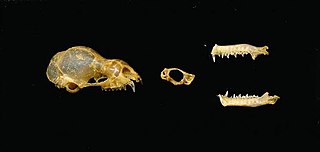 W
WThe ashy roundleaf bat is a species of bat in the family Hipposideridae found in India, Indonesia, Laos, Malaysia, Myanmar, Pakistan, Thailand, and Vietnam.
 W
WThe black-bearded tomb bat is a species of sac-winged bat. It is found in South and South East Asia.
 W
WBlyth's horseshoe bat is a species of bat in the family Rhinolophidae. It is found across southern Asia from Afghanistan to Vietnam. The species can be identified from its pointed, bifid sella.
 W
WCantor's roundleaf bat is a species of bat in the family Hipposideridae. It is found in Bangladesh, Brunei, Cambodia, India, Indonesia, Laos, Malaysia, Sri Lanka, Thailand and Vietnam.
 W
WHardwicke's woolly bat is a species of vesper bat in the family Vespertilionidae.
 W
WThe intermediate roundleaf bat is a species of bat in the family Hipposideridae. It is found in Bangladesh, Cambodia, China, India, Indonesia, Laos, Malaysia, Myanmar, Thailand, and Vietnam.
 W
WThe least horseshoe bat is a species of bat in the family Rhinolophidae. It is found in China, India, Indonesia, Laos, Malaysia, Myanmar, Nepal, Thailand and Vietnam.
 W
WThe lesser Asiatic yellow bat is a species of vesper bat. It is found in Bangladesh, India, Indonesia, Malaysia, Pakistan, the Philippines, Sri Lanka, and Taiwan.
 W
WThe lesser bamboo bat or lesser flat-headed bat is one of the smallest species of vesper bat, and is native to Southeast Asia.
 W
WThe lesser false vampire bat is a bat found in South Asia and Southeast Asia from Sri Lanka and India in the west to Indonesia and the Philippines in the east. They live in caves and tree hollows. They are insectivorous.
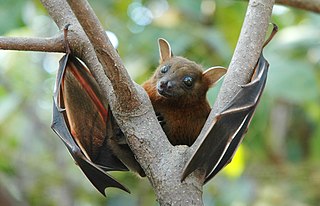 W
WThe lesser short-nosed fruit bat is a species of megabat within the family Pteropodidae. It is a small bat that lives in South Asia and Southeast Asia. It weighs between 21 and 32 grams, and/or 70 to 127 mm. It occurs in many types of habitat, but most frequently in disturbed forest, including lower montane forest and tropical lowland rain forest, plus gardens, mangroves, and vegetation on beaches.
 W
WThe long-tongued nectar bat, also known as the northern blossom bat, honey nectar bat, least blossom-bat, dagger-toothed long-nosed fruit bat, and lesser long-tongued fruit bat, is a species of megabat. M. minimus is one of the smallest species in the family Pteropodidae, with an average length of 60–85 mm. It has a reddish-brown colouring with relatively long hair compared to the other species. The hair on the abdomen is a lighter colour, and a dark brown stripe runs bilaterally down the top of the head and back.
 W
WThe naked-rumped pouched bat, also known as pouched tomb bat, is a species of sac-winged bat in the family Emballonuridae.
 W
WThe Pomona roundleaf bat, Pomona leaf-nosed bat, or Andersen's leaf-nosed bat is a species of bat in the family Hipposideridae. It is found in Bangladesh, Cambodia, China (southern), India, Laos, Malaysia (Peninsular), Myanmar, Nepal, Thailand and Vietnam. It roosts in small colonies, consisting of a few individuals, in caves and crevices. It appears to tolerate modified habitats well, even occurring in urban areas.
 W
WThe wrinkle-lipped free-tailed bat is a species of bat in the family Molossidae. It is found in Bangladesh, Bhutan, Cambodia, China, Cocos (Keeling) Islands, India, Indonesia, Laos, Malaysia, Myanmar, Nepal, the Philippines, Sri Lanka, Thailand and Vietnam.
 W
WThe cave nectar bat, dawn bat, common dawn bat, common nectar bat or lesser dawn bat is a species of megabat within the genus Eonycteris. The scientific name of the species was first published by Dobson in 1871.
 W
WThe clouded leopard is a medium-sized wild cat occurring from the Himalayan foothills through mainland Southeast Asia into southern China. Since 2008, it is listed as Vulnerable on the IUCN Red List. Its total population is suspected to be fewer than 10,000 mature individuals, with a decreasing population trend, and no single population numbering more than 1,000 adults.
 W
WThe black-shanked douc is an endangered species of douc found mostly in the forests of eastern Cambodia, with some smaller populations in Vietnam. This species is unique among the doucs in having a largely greyish-blue face. No global population estimate exists, although the Wildlife Conservation Society report an estimated 23,000 individuals present in Cambodia's Keo Seima Wildlife Sanctuary. Prior to the discovery of the significance of this population, the largest populations were believed to be in adjacent Vietnam, where the largest known population is around 500-600 individuals. They are primarily arboreal and their diet consists on leaves, of which they obtain most of their water.
 W
WThe red-shanked douc is a species of Old World monkey, among the most colourful of all primates. It is an arboreal and diurnal monkey that eats and sleeps in the trees of the forest.
 W
WThe fishing cat is a medium-sized wild cat of South and Southeast Asia. Since 2016, it is listed as Vulnerable on the IUCN Red List. Fishing cat populations are threatened by destruction of wetlands and have declined severely over the last decade. The fishing cat lives foremost in the vicinity of wetlands, along rivers, streams, oxbow lakes, in swamps, and mangroves.
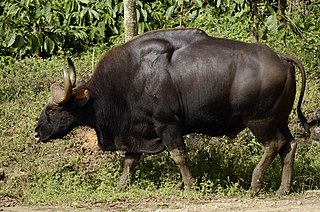 W
WThe gaur, also known as Indian bison, is native to South and Southeast Asia and has been listed as Vulnerable on the IUCN Red List since 1986. The global population has been estimated at maximum 21,000 mature individuals by 2016. It declined by more than 70% during the last three generations, and is extinct in Sri Lanka and probably also in Bangladesh. Populations in well-protected areas are stable and increasing.
 W
WGeoffroy's rousette is a species of megabat or Old World fruit bats. It is one of 10 species in the genus Rousettus.
 W
WThe giant muntjac,, sometimes referred to as the large-antlered muntjac, is a species of muntjac deer. It is the largest muntjac species and was discovered in 1994 in Vũ Quang, Hà Tĩnh Province of Vietnam and in central Laos. During inundation of the Nakai Reservoir in Khammouane Province of Laos for the Nam Theun 2 Multi-Purpose Project, 38 giant muntjac were captured, studied, and released into the adjacent Nakai-Nam Theun National Protected Area. Subsequent radio-tracking of a sample of these animals showed the relocation was successful. The species is also located in parts of eastern Cambodia, as well as the Trường Sơn Mountains.
 W
WThe pileated gibbon is a primate in the gibbon family, Hylobatidae.
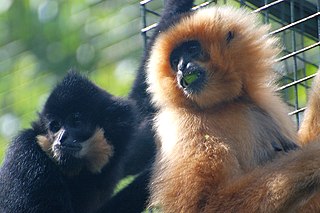 W
WThe yellow-cheeked gibbon, also called the golden-cheeked gibbon, yellow-cheeked crested gibbon, the golden-cheeked crested gibbon, red-cheeked gibbon, or the buffed-cheeked gibbon, is a species of gibbon native to Vietnam, Laos, and Cambodia.. The species was discovered and named after the British naturalist Gabrielle Maud Vassal.
 W
WThe greater bamboo bat is a species of vesper bat in the family Vespertilionidae. It is found in Cambodia, China, India, Indonesia, Laos, Malaysia, Myanmar, the Philippines, Singapore and Thailand.
 W
WHarrison's tube-nosed bat is a species of vesper bats (Vespertilionidae). Within the genus Murina, it belongs to the so-called 'cyclotis-group'.
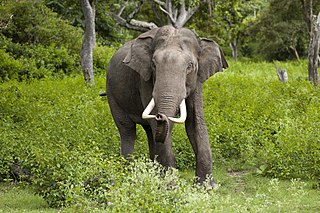 W
WThe Indian elephant is one of three extant recognised subspecies of the Asian elephant and native to mainland Asia.
 W
WThe Indochinese hog deer, also called the Annamite deer or Thai hog deer, is a species of hog deer native to Cambodia, Laos, China and Vietnam. It has been extirpated from Thailand.
 W
WThe Indochinese leopard is a leopard subspecies native to mainland Southeast Asia and southern China. In Indochina, leopards are rare outside protected areas and threatened by habitat loss due to deforestation as well as poaching for the illegal wildlife trade. The population trend is suspected to be decreasing. As of 2016, the population is thought to comprise 973–2,503 mature individuals, with only 409–1,051 breeding adults. The historical range has decreased by more than 90%.
 W
WThe kouprey is a little-known, forest-dwelling, wild bovine species native to Southeast Asia. A young male was sent to the Vincennes Zoo in 1937 where it was described by the French zoologist Achille Urbain and was declared the holotype. The kouprey has a tall, narrow body, long legs, a humped back and long horns.
 W
WGermain's langur is a lutung native to Thailand, Burma, Cambodia, Laos and Vietnam. The Old World monkey was previously included in Trachypithecus cristatus and Trachypithecus villosus.
 W
WThe leopard cat is a small wild cat native to continental South, Southeast, and East Asia. Since 2002 it has been listed as Least Concern on the IUCN Red List as it is widely distributed although threatened by habitat loss and hunting in parts of its range.
 W
WThe lesser mouse-deer, lesser Malay chevrotain, or kanchil is a species of even-toed ungulate in the family Tragulidae.
 W
WThe spotted linsang is a linsang, a tree-dwelling carnivorous mammal, native to much of Southeast Asia. It is widely, though usually sparsely, recorded, and listed as Least Concern on the IUCN Red List.
 W
WThe Bengal slow loris or northern slow loris is a strepsirrhine primate and a species of slow loris native to the Indian subcontinent and Indochina. Its geographic range is larger than that of any other slow loris species. Considered a subspecies of the Sunda slow loris (N. coucang) until 2001, phylogenetic analysis suggests that the Bengal slow loris is most closely related to the Sunda slow loris. However, some individuals in both species have mitochondrial DNA sequences that resemble those of the other species, due to introgressive hybridization. It is the largest species of slow loris, measuring 26 to 38 cm from head to tail and weighing between 1 and 2.1 kg. Like other slow lorises, it has a wet nose (rhinarium), a round head, flat face, large eyes, small ears, a vestigial tail, and dense, woolly fur. The toxin it secretes from its brachial gland differs chemically from that of other slow loris species and may be used to communicate information about sex, age, health, and social status.
 W
WThe pygmy slow loris is a species of slow loris found east of the Mekong River in Vietnam, Laos, eastern Cambodia, and China. It occurs in a variety of forest habitats, including tropical dry forests, semi-evergreen, and evergreen forests. The animal is nocturnal and arboreal, crawling along branches using slow movements in search of prey. Unlike other primates, it does not leap. It lives together in small groups usually with one or two offspring. An adult can grow to around 19 to 23 cm long and has a very short tail. It weighs about 450 g (1.0 lb). Its diet consists of fruits, insects, small fauna, tree sap, and floral nectar. The animal has a toxic bite, which it gets by licking a toxic secretion from glands on the inside of its elbows. The teeth in its lower jaw form a comb-like structure called a toothcomb that is used for scraping resin from tree bark.
 W
WThe crab-eating macaque, also known as the long-tailed macaque, is a cercopithecine primate native to Southeast Asia. It is referred to as the cynomolgus monkey in laboratories. It has a long history alongside humans; it has been alternately seen as an agricultural pest, sacred animal in some temples, and more recently, the subject of medical experiments.
 W
WThe stump-tailed macaque, also called the bear macaque, is a species of macaque found in South Asia. In India, it is found in south of the Brahmaputra River, in the northeastern part of the country. Its range in India extends from Assam and Meghalaya to eastern Arunachal Pradesh, Nagaland, Manipur, Mizoram and Tripura.
 W
WThe marbled cat is a small wild cat native from the eastern Himalayas to Southeast Asia, where it inhabits forests up to 2,500 m (8,200 ft) altitude. As it is present in a large range, it has been listed as Near Threatened on the IUCN Red List since 2015.
 W
WThe masked palm civet, also called the gem-faced civet, is a palm civet species native to the Indian subcontinent and Southeast Asia. It has been listed as least concern on the IUCN Red List since 2008 as it occurs in many protected areas, is tolerant to some degree of habitat modification, and widely distributed with presumed large populations that are unlikely to be declining.
 W
WThe crab-eating mongoose is a mongoose species ranging from the northeastern Indian subcontinent and Southeast Asia to southern China and Taiwan. It is listed as Least Concern on the IUCN Red List.
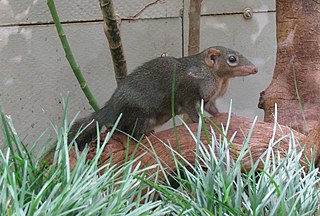 W
WThe northern treeshrew is a treeshrew species native to Southeast Asia.
 W
WThe hairy-nosed otter is a semiaquatic mammal endemic to Southeast Asia and one of the rarest and least known otter species. It is threatened by loss of natural resources and poaching.
 W
WThe short-tailed gymnure is a small mammal from the family of the Erinaceidae. The scientific name of the species is first published by Salomon Müller in 1840.
 W
WThe small Indian civet is a civet native to South and Southeast Asia. It is listed as Least Concern on the IUCN Red List because of its widespread distribution, widespread habitat use and healthy populations living in agricultural and secondary landscapes of many range states.
 W
WThe small-toothed palm civet, also known as the three-striped palm civet, is a palm civet native to dense forests of Southeast Asia, from the Assam district of India to Indochina and the Malay Peninsula and on Sumatra, Bangka, Java, Borneo, and numerous small nearby islands of Indonesia.
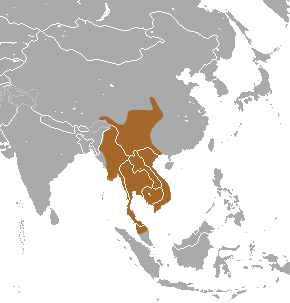 W
WThe Southeast Asian shrew is a species of mammal in the family Soricidae. It is found in Cambodia, India, China, Laos, Malaysia, Myanmar, Thailand, and Vietnam.
 W
WThe Sunda pangolin, also known as the Malayan or Javan pangolin, is a species of pangolin.
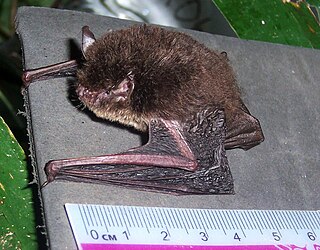 W
WThe wall-roosting mouse-eared bat, or Nepalese whiskered myotis is a species of vesper bat whose type locality is Nepal.
 W
WWalston's tube-nosed bat is a species in the vesper bat family Vespertilionidae, found in the Greater Mekong region of Southeast Asia, specifically the Đắk Lắk Province of Vietnam and the Koh Kong and Ratanakiri provinces of Cambodia. This species was discovered in northeastern Cambodia in the Van Sai Protected Forest. They have tube-shaped nostrils which assist them with their feeding.
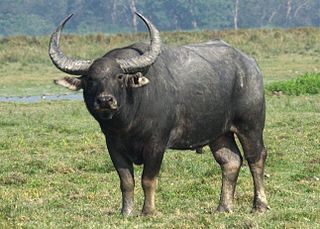 W
WThe wild water buffalo, also called Asian buffalo, Asiatic buffalo and wild Asian buffalo, is a large bovine native to the Indian subcontinent and Southeast Asia. It has been listed as Endangered in the IUCN Red List since 1986, as the remaining population totals less than 4,000. A population decline of at least 50% over the last three generations is projected to continue. The global population has been estimated at 3,400 individuals, of which 3,100 (91%) live in India, mostly in Assam. The wild water buffalo is the probable ancestor of the domestic water buffalo.
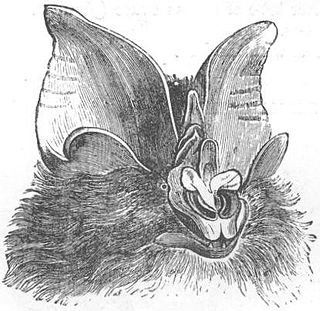 W
WThe woolly horseshoe bat is a species of bat in the family Rhinolophidae.